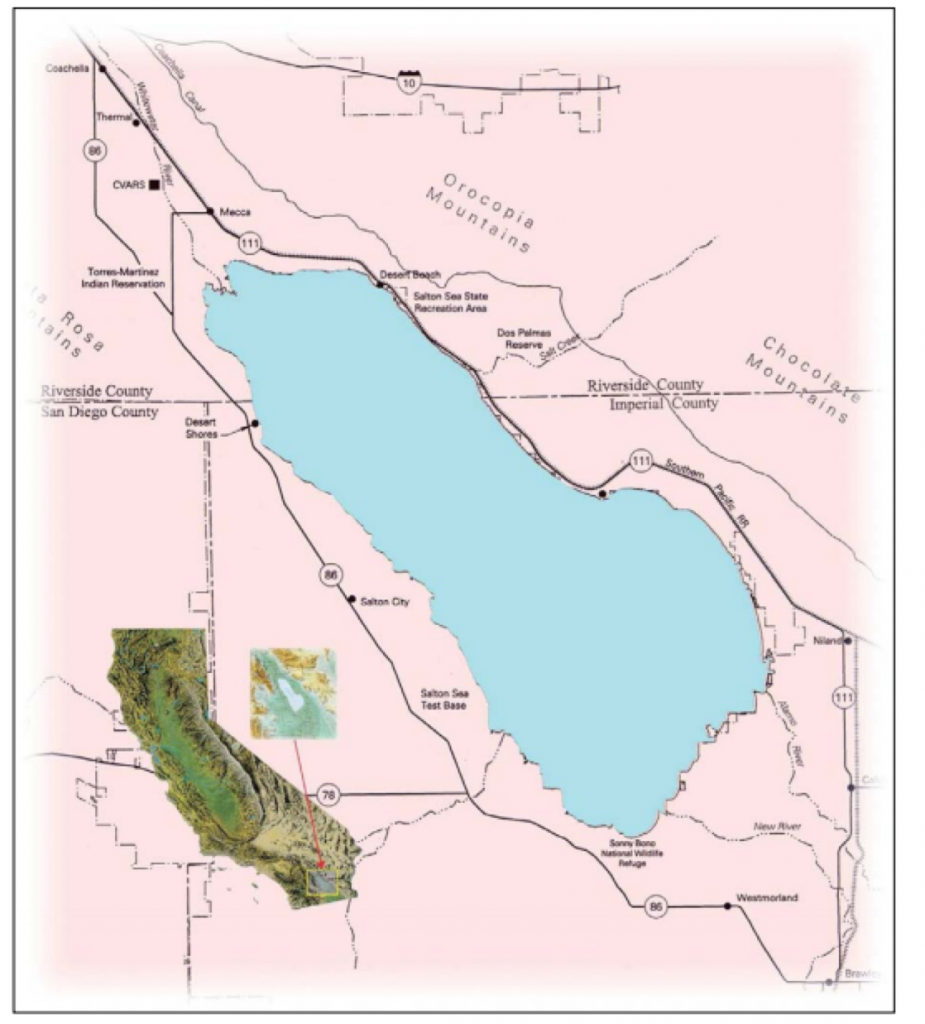
Introduction
The Salton Sea has a fascinating past– it is both a “natural” and a “man made” body of water. The Salton Sea (technically a lake, so we will refer to it using that word) is in a basin (a natural hollow place where water can collect) called the Salton Basin, that used to hold one of the biggest lakes in the world, called Lake Cahuilla. Depending on the fullness and the path of the Colorado River, the basin went back and forth between being either a large lake or a huge dusty lakebed over thousands of years. For a lot of modern history, it was a dry lakebed. That is, until 1900, when the California Development Company began building a complicated canal system for irrigation in the area. A series of engineering problems and mishaps occurred, and in 1905 the Colorado River overflowed into the basin. What resulted was the Salton Sea. Since then, the Salton Sea has become a collection point for agricultural runoff from the New River and the Alamo River in the Imperial Valley as well as the Whitewater River in the Coachella valley.
Despite its accidental beginning, over the years the Salton Sea has served many important functions for the California ecosystem. Today, the lake is home to wide variety of bird species and provides important habitat to birds migrating along the Pacific Flyway, including endangered species of birds. Three kinds of fish live either in the lake or in the channels that run off into it, including endangered Desert Pupfish. More than 400,000 people live in the area around the lake, and it has served as an important destination for tourism and recreation largely because of the biodiversity of species that inhabit it. Interestingly, the Salton Sea became a cultural hotspot in the mid-2oth century. A number of resorts were built along the shore and people bought land for vacation homes. Tourism has declined since then because the sea has gone through multiple changes, leading to receding shoreline, increasing salinity, and fish die offs. Yet, many people still visit the sea, especially for the excellent bird watching.
Imminent Crisis Ahead
The shrinkage of the Salton Sea, if nothing is done to address the problems that it will create, poses large threats to both people and wildlife. As the water level shrinks, it will expose large amounts of dry lakebed. This will create toxic dust, which is extremely harmful to the respiratory health of people living anywhere that the dust will travel– which will likely effect the air quality of the entire Southern California region. This brings up important Environmental Justice concerns, because in the Imperial Valley children’s emergency room visits for asthma already occur at twice the rate of the average for California.
Unfortunately, the window of time to act to address these important problems in advance is closing. On January 1, 2018 the Imperial Irrigation District will no longer be required to pump water from the Colorado River directly into the sea. At that time, the Quantification Settlement Agreement (QSA) will take effect. The QSA is water agreement between multiple parties who share Colorado River water. The terms of the agreement are complicated, but the main issue for the lake is that as the QSA takes effect, much of the water that runs off of fields in the Imperial Irrigation District and feeds the Salton Sea will be transferred to San Diego. This means that the problems facing the lake are going to get rapidly worse. The surface of the sea will drop about 20 feet in the next 10 years and shrink the sea’s volume by more than 60 percent. This will triple the salinity of the Salton Sea. This will cause large changes to the ecology of the sea, as well as large increases in toxic dust.
If the Sea is allowed to dry without treatment, it will produce 17 tons of unhealthy dust a day, according to the Pacific Institute. It is clear that things are changing for the Salton Sea. While it may not be possible to maintain the “status quo,” it is very important that the local, state, and national governments act quickly to intervene and find ways to manage the Salton Sea so we do not create massive problems with dust. If we work hard to carefully manage this ecosystem, it is possible to preserve habitat for fish and birds, recreation for people, and prevent disastrous public health problems. However, this requires the support of all Californians to learn about the issues facing the sea and support the large initiative to manage the lake so it remains sustainable into the future. We all share in the potential disastrous effects of not working to manage this complicated man-made and natural ecosystem.
Information cited from
https://www.kcet.org/shows/socal-connected/saving-the-salton-sea
http://www.wired.com/2012/09/salton-sea-saga/
http://www.invisiblesea.org/data/
http://www.huffingtonpost.com/2012/04/25/salton-sea-dry-san-diego-water-authority-plan-california_n_1452938.html
http://www.usbr.gov/lc/region/saltnsea/pdf_files/statusrpt.pdf